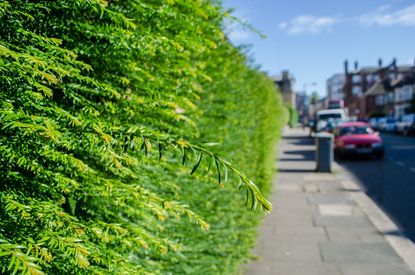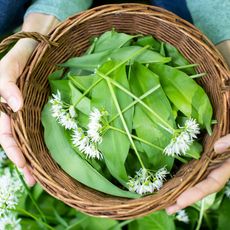Best Sound Barrier Plants To Block The Noise From Busy Roads
Enjoy a little more peace and quiet by using plants as sound barriers around your home for noise-blocking the din of traffic.


Best Sound Barrier Plants To Grow If You Live By A Busy Road
Using plants as sound barriers is one effective and beautiful way to block unwanted noise. Urban life can be noisy. Airplanes, semis, and car traffic all combine with the sounds of children's play and nature. But it’s the first 3 that need to be dimmed and stilled in order to enjoy the last 2. Commonly used along interstate corridors in city settings, sound-absorbing plants can dull the din and allow us to enjoy the more pleasant auditory senses.
Do Noise Blocking Plants Really Work?
Studies on noise abatement have been conducted with plants, especially with regard to traffic. Sound barrier plants such as spruce, poplar, and beech were planted and monitored. It was found that densely planted trees with at least a span of 40 feet (12 m), were effective noise blocking plants. This was especially true when the rows of plantings were situated perpendicular to the offending noise.
Such a buffer does not have to be composed of the same species. In fact, a mixed planting deflects unwanted noise almost better. Varied heights combined with broadleaf specimens will not only repel the noise but any that does get through becomes absorbed.
Mixed broadleaf and evergreen conifer plants can lower noise by 10 decibels. Broadleaf thickets need to be 25 feet (7.62 m) while conifers should be 50-100 feet (15-30 m) broad. Even deciduous plants are effective sound absorbing plants. For maximum benefits the plants should be dense, varied, and have foliage touching the ground.
Best Sound Barrier Plants
Hedges are classic landscape forms that provide not only noise abatement but also beauty. Plants like arborvitae and privet make excellent hedges that can be left to grow naturally or manicured.
Establishing a sound barrier will take time as plants grow in and get mature. So selecting the best plants for noise reduction requires consideration of site, soil, light, mature size, and much more. If you need year round noise reduction, evergreen plants or a combination of deciduous and evergreen will provide the best reduction of noise as compared to a fully deciduous area.
- Photinia Gorgeous red-tipped evergreen leaves that grow up to 20 feet (6.1 m) tall.
- Yew Many forms. Dark green leaves and red berries grow up to 20 feet (6.1 m).
- Leyland cypress Columned form and evergreen foliage. Fast growing to 70 feet (21 m).
- Holly Many varieties. Attractive glossy, green leaves and shiny, red berries. May achieve 25 feet (7.6 m) at maturity.
- Virginia juniper Also named Eastern red cedar, this is a pyramid-shaped conifer that may get 40 feet (12 m) tall.
- Deodar cedar Gently swayed branches and an appealing form. Grows nearly 3 feet (.91 m) with a mature height of 40 feet (12 m).
- Viburnum Many varieties. Deciduous with broad leaves and produces clusters of blooms. Some varieties grow to 8 feet (2.4 m).
- Wax myrtle A broadleaf, evergreen shrub that grows 15 feet (4.6 m) high and wide.
- Western red cedarFast growing 40 feet ( 12m. ) tall with a spread of 15 feet (4.6 m).
- Southern magnolia Dense glossy foliage. May get 80 feet (24 m) with half that in width.
- Cherry laurel A native selection for North America that may grow 30 feet (9 m). May be allowed to grow naturally or pruned to a formal hedge.
How to Use Plants as Sounds Barriers
For the best noise abatement formation, experts recommend a combination of plant forms, primarily evergreen, with broad leaves and foliage near the ground. Combine these with grass or groundcover which will further muffle noise.
Gardening tips, videos, info and more delivered right to your inbox!
Sign up for the Gardening Know How newsletter today and receive a free download of our DIY eBook "Bring Your Garden Indoors: 13 DIY Projects For Fall And Winter".
Low-growing plants should be planted closest to the noise source, with taller specimens behind them. A third row behind these aimed at the home or garden will provide further protection and may include flowering or fruiting plants.
If there is space, an earthen berm at the entry point of the sound will dim the noise even further when planted with a combination of noise-blocking plants. A berm combined with plant material can reduce noise by 6-15 decibels. That is up to one-half as loud as conditions were before installation.
This may be a project that takes months or years to perfect, but it is worth the effort to bring a bit more peace to your living space when you’re in an urban setting.

Jackie Carroll has written over 500 articles for Gardening Know How on a wide range of topics.
-
 Elegant Exotics: 8 Beautiful Amaryllis Varieties That Will Brighten Any Holiday Display
Elegant Exotics: 8 Beautiful Amaryllis Varieties That Will Brighten Any Holiday DisplayWhether red, pink, white or variegated, the right amaryllis varieties can enhance any living space, especially during the holidays. We round up eight of the most exquisite
By Bonnie L. Grant
-
 Forage For Herbs: 7 Tasty And Safe Wild Herbs To Pick Close To Your Own Backyard
Forage For Herbs: 7 Tasty And Safe Wild Herbs To Pick Close To Your Own BackyardIn addition to growing your own herbal staples, did you know there are several wild options out there that are safe and tasty – and free? Try foraging these 7 wild herbs
By Amy Grant